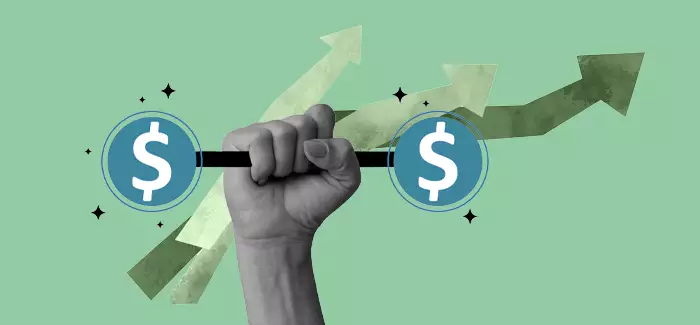How to improve your credit score

Written by Michael Feder

Reviewed by Chris Conway, Director of Financial Education Initiatives and Repayment Management

A credit score is more than just a three-digit number. It can have a significant impact on your financial life. For example, when you are applying for a mortgage, renting an apartment or obtaining a car loan, your credit score can play a role. So, if you’re wondering how to improve your credit score, understanding what it is and how it’s calculated is a great place to start.
Learning how to improve your credit score
Before you start learning how to improve your credit score, it’s helpful to understand the connection between your credit report and your credit score. One way is to compare a credit report to a school report card. Just as a report card details how well you’re doing in your classes, your credit report provides a detailed record of your financial activity. It includes how responsible you’ve been in making on-time payments, how long you’ve had accounts open, how much credit you’re using and more.
If your credit report is like a report card, your credit score is similar to a GPA. It’s a numerical rating of your creditworthiness whose calculation is based on the information listed in your credit reports. That’s why reviewing a credit report can show you how to improve your credit score. By consistently monitoring and working on your credit, you can help ensure that your financial habits are driving your score in the right direction.
Lenders use credit scores to determine the risk of lending you money. Your credit score can be the determining factor for whether you’re approved for an apartment, auto loan, mortgage, student loans or lines of credit. It may also affect how much you pay for insurance or how much interest you pay on borrowed money.
The higher your score, the more likely you are to get approved for loans and credit cards at favorable rates. Low scores can indicate that you have little to no credit, making it difficult for lenders to determine whether you are financially responsible. Low scores can also indicate how badly you’ve handled debt in the past and can give the impression that you are irresponsible when it comes to borrowing and paying back.Â
How is your credit score calculated?
Understanding the components of how credit scores are calculated is key to knowing how to improve your credit score. Five factors can influence your score:
1.     Payment history (35%): Your monthly payment history is reported to credit bureaus. This factor takes into account on-time and delinquent payments.
2.     Amount owed (30%): This refers to your credit utilization ratio, also known as your debt-to-credit ratio. This represents the amount of credit you have available in relation to how much of that credit you’re using.
3.     Length of credit history (15%): When it comes to this factor, the best credit is old credit. The longer your accounts are open, the better it is for your credit profile. Lenders typically prefer to see a lengthy and proven track record.
4.     Credit mix (10%): Borrowing from a diverse mix of credit types and lenders suggests that you are able to manage different types of credit.
5.     New credit (10%): Unfortunately, new credit can have a negative impact on your credit score. Frequently opening new credit accounts or initiating a lot of credit inquires may suggest an overreliance on credit, which will lower your credit score.Â
Scoring models
Not all scores are created equal. There are two main types of credit scores you may encounter: FICO or VantageScore:
- FICO (Fair Isaac Corporation) score: The most commonly used score by lenders.
- FICO score 8: The most commonly used version by lenders for credit cards and personal loans.
- FICO score 9: Medical debt is treated differently. And if rental payment history is reported, it can affect your score.
- FICO industry scores (auto, mortgage and bank card/credit card): These versions are used specifically by auto lenders, mortgage lenders and credit card companies and weigh certain components more heavily.
- VantageScore: The three major credit bureaus (Experian, TransUnion and Equifax) launched VantageScore in 2006 as a competitor to FICO. VantageScore uses similar criteria to evaluate creditworthiness, but it describes each criterion’s level of influence rather than ascribing a percentage to its weight. So, where FICO might award 35% of a score to a person’s payment history, VantageScore simply labels the same category as “extremely influential.” These are the six VantageScore categories: Â
- Payment history (extremely influential)
- Credit utilization, or the percentage of your credit limit you’re using (highly influential)
- Length of credit history and a mix of credit accounts (highly influential)
- Amounts you owe (moderately influential)
- Recent credit behavior (less influential)
- Available credit (less influential)
Your score can vary depending on which model a lender uses and which credit bureau they check, so understanding both is critical for learning how to improve credit scores.
Making on-time payments
Payment history is the most important factor in calculating your FICO score and shows whether you make on-time payments. This section of your report should list all your accounts, if the required payment was made on time or late (and if late, how late), and how delinquent the account is.
Where do you start when it comes to how to improve credit scores? Start with paying your bills on time every month. This is crucial to maintaining and improving your score. If you have a history of late payments, your credit score will improve over time as you make consistent, on-time payments and as the late payments start to age.Â
Tips for making on-time payments:
- Setting up automatic payments helps ensure you never miss a due date.
- Use reminders and alerts on your phone to update you on upcoming payments.Â
How late payments affect your score
Late payments remain on your credit report for seven years and make the biggest impact during the first couple of years. How late the payment is also affects the impact to your score. Â For example, a 90-day delinquency would affect your score more than a 30-day delinquency. Every late payment can result in a significant credit score reduction. Â
Managing credit utilization
Getting a credit card is only the first step to building good credit.
Understanding the credit utilization ratio
One significant factor in how to improve your credit score is managing your credit utilization ratio. This compares your credit card balances to your available credit limits. Your usage should ideally remain below 30% of your available credit. For example, if you have a $1,000 limit on a credit card, aim to keep the balance below $300. If your utilization exceeds 30%, it can negatively affect your score.Â
Strategies to lower credit card balances
- Always aim to pay more than the minimum payment. This reduces your principal faster and can save you money on interest over time.
- Consider using the debt avalanche method by paying off the cards with the highest interest rates first. This will save you money in the long run by reducing the amount of interest you pay.
- Consider transferring high-interest balances to a credit card with a lower interest rate or a 0% introductory APR offer. Be sure to pay off the balance before the promotional period ends to avoid high interest fees.
- Review your budget and cut back on non-essential purchases. Use the money you save to make extra payments toward your credit card balances. Apply any extra money like tax refunds, bonuses or gifts toward your credit card balances.Â
How to manage your credit utilization:
- Pay down or pay off existing balances to lower your utilization ratio.
- Request credit limit increases to lower your utilization percentage (as long as you don’t use the increased amount).
- Use several credit cards instead of a single one to prevent maxing out accounts.
Building a diverse credit portfolio
Having a mix of credit accounts can be beneficial for knowing how to improve your credit score. Doing so shows lenders that you’re capable of handling various types of credit responsibly. However, only open credit accounts that you truly need; don’t take on debt merely to boost your credit mix.Â
Types of credit accounts to consider
There are two types of credit:
- Revolving (credit cards): This type of credit allows you to borrow up to a certain amount, with the option to repay and borrow again. Managing your revolving credit effectively (by keeping balances low and making consistent on-time payments) is a key factor in improving your credit score.
- Installment (fixed payments): This type of credit, such as personal loans, auto loans and mortgages, is another way you can work on improving your credit score. With installment loans, you borrow a fixed amount and repay it over a predetermined period. By making payments on time, you contribute to improving your credit score and show lenders that you can handle credit responsibly.Â
New credit applications and understanding hard inquiriesÂ
Each time you apply for new credit, a hard inquiry is made on your report. A hard inquiry occurs when a lender or credit card issuer checks your credit report as part of its decision-making process. This practice temporarily lowers your score.
FICO considers the following in regard to new credit:
- How many inquiries have been recently made?
- How many new accounts have been opened within the past 6 to 12 months?Â
Best practices for applying for new credit
Since opening too many new accounts in a short time can be damaging, consider only opening accounts you truly need. If approved, you will likely see a slight decrease in your score, but if you continue to make on-time payments and keep your debt-to-credit ratio low, you should see an increase in no time.Â
The process to improve a credit scoreÂ
Although it takes time to build and improve your credit score, it’s possible! Here is an overview of actionable steps:
- Review your credit reports for errors.
- Pay your bills on time.
- Keep your credit utilization under 30% of your total available credit.
- Use a secured credit card if you’re new to credit or need to rebuild and cannot obtain an unsecured card. Secure credit cards require a deposit as collateral, which reduces the risk to the lender. The amount you put down becomes your credit limit, and utilization of the card is the same as an unsecured card. Responsible use can help improve credit scores.
- Get a co-signer if you’re having trouble getting approved for credit. You can ask a family member or friend with good credit to co-sign a loan or credit card application.
Improving your credit score may take time, but it’s entirely within your control.Â
The impact of collections on your credit score
One damaging factor to your credit score is having accounts sent to collections. A collection account stays on your credit report for seven years from the original delinquency date (not the date it opened with the collection agency) and can drastically lower your score.
If you have a collection account, verify that it’s accurate. Typically, you have 30 days to do so from their initial correspondence. If it’s not valid, you can dispute it directly with the credit bureaus. If it is valid, contact the collection agency to try to negotiate a settlement.
Settling for less than what’s owed won’t exacerbate the negative impact on your score, and clearing your account from collections will eventually improve your overall credit profile.
You may also try negotiating a “pay to delete” agreement, where the collection agency agrees to remove the account from your report in exchange for payment. Not all agencies will honor this request, but it’s worth making. If they agree, be sure to get it in writing.
Debunking credit score myths
There are many myths about credit scores. Here are a few to watch out for:
- Checking your credit hurts your score: Checking your own credit is a soft inquiry. It does not affect your credit scores.
- Paying off debt automatically improves your score: While paying off debt is important, it may not immediately improve your score, especially if there are other factors affecting it, like late payments or high credit utilization. It also depends on the type of loan you paid off (revolving or installment).
- You lose history when you close accounts: Credit history remains for an additional 10 years from the last payment date. As long as it’s on the report, the history is included in your scores. When you close a credit card, you reduce your overall credit availability, which can increase your credit utilization ratio if you are carrying balances on other cards. A higher utilization rate can negatively impact your credit score.
- Debt-to-income ratio affects your credit score: Your income is not reported to credit bureaus. While important for loan approvals, your debt-to-income ratio doesn’t factor into your credit score calculation.Â
Enjoying financial flexibility by knowing how to improve your credit score
Understanding how to improve your credit score is not just about avoiding debt. It’s about managing it responsibly and staying proactive. Curious to learn more about other personal finance topics like budgeting and investing? Check out the webinars offered by °®¶ą´«Ă˝!
All financial decisions should be made carefully and potentially with the guidance of a financial planning professional.

ABOUT THE AUTHOR
A graduate of Johns Hopkins University and its Writing Seminars program and winner of the Stephen A. Dixon Literary Prize, Michael Feder brings an eye for detail and a passion for research to every article he writes. His academic and professional background includes experience in marketing, content development, script writing and SEO. Today, he works as a multimedia specialist at °®¶ą´«Ă˝ where he covers a variety of topics ranging from healthcare to IT.

ABOUT THE REVIEWER
As Director of Financial Education Initiatives and Repayment Management, Chris Conway works with departments across the University to provide resources that allow students to make more informed financial decisions. She is also an adjunct faculty member for the Everyday Finance and Economics course at the University, and she chairs the National Council of Higher Education Resources College Access and Success Committee. Conway is committed to helping college students make the right financial decisions that prevent future collection activity.
This article has been vetted by °®¶ą´«Ă˝'s editorial advisory committee.Â
Read more about our editorial process.
Read more articles like this:


